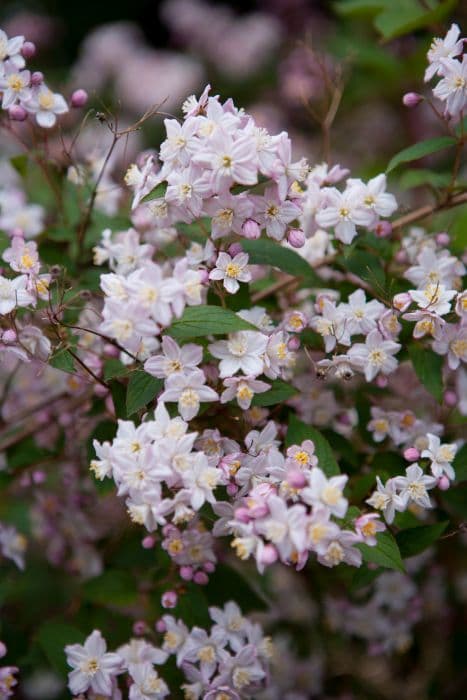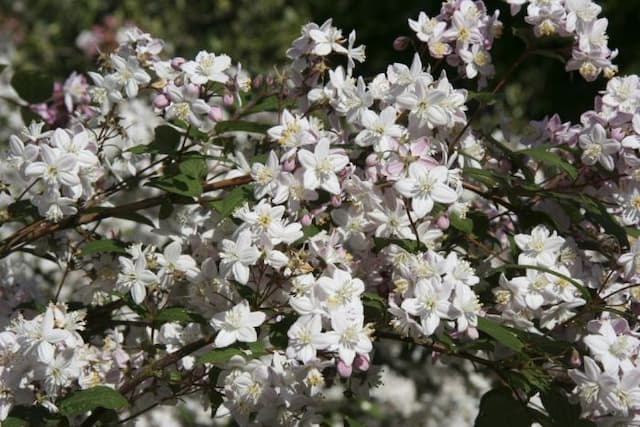Mountain Hydrangea Hydrangea serrata 'Diadem' (L)

ABOUT
Hydrangea serrata 'Diadem' is a deciduous shrub known for its ornamental qualities, exhibiting a lush, rounded appearance with dense foliage. The leaves are broadly ovate with pointed tips and toothed edges, displaying a deep green color that can acquire purplish hues in the fall. When it comes to the flowers, this variety of Hydrangea is particularly striking with its flat-topped clusters, known as corymbs or lacecaps. Each flower head consists of a central mass of tiny, fertile flowers surrounded by a halo of larger, showier, sterile flowers, which can range in color from blue to pink depending on the soil's acidity. These blossoms are rich in texture and often attract pollinators such as bees and butterflies during their blooming period. The stems are sturdy, holding the flower heads upright and spreading outward, creating a mounded form that is rich with color and vitality throughout the growing season.
About this plant
 Names
NamesFamily
Hydrangeaceae.
Synonyms
Mountain Hydrangea, Tea of Heaven, Sawtooth Hydrangea.
Common names
Hydrangea serrata 'Diadem' (L).
 Toxicity
ToxicityTo humans
The mountain hydrangea (Hydrangea serrata) has parts that can be potentially toxic if ingested. However, poisoning is generally not common from casual handling or contact. The toxic principle is primarily in the leaves and flowers, which contain cyanogenic glycosides. These compounds can release cyanide in the body when chewed or digested. Symptoms of poisoning can include nausea, vomiting, and diarrhea. In more severe cases, ingestion can lead to dizziness, rapid pulse, drop in blood pressure, convulsions, and respiratory failure. It is important to seek medical attention if ingestion is suspected.
To pets
The mountain hydrangea is also toxic to pets, such as dogs and cats, if ingested. Similar to its effects on humans, the plant contains cyanogenic glycosides, primarily in the leaves and flowers. If a pet consumes parts of this plant, it could experience symptoms such as vomiting, diarrhea, lethargy, abdominal pain, and in more severe cases, depression, labored breathing, and seizures. It is important to keep the mountain hydrangea out of reach of pets and consult with a veterinarian immediately if your pet has ingested any part of the plant.
 Characteristics
CharacteristicsLife cycle
Perennials
Foliage type
Deciduous
Color of leaves
Green
Flower color
Varies
Height
2-3 feet (60-90 cm)
Spread
2-4 feet (60-120 cm)
Plant type
Shrub
Hardiness zones
6
Native area
Japan Korea
Benefits
 General Benefits
General Benefits- Aesthetic Appeal: Adds visual interest to gardens with its beautiful flowers and foliage.
- Seasonal Color: Offers a range of colors with blooms that can change color based on soil pH, typically blue in acidic soil and pink in alkaline.
- Versatility: Suitable for a variety of garden designs, including borders, foundation plantings, and as specimen plants.
- Attracts Pollinators: Invites beneficial insects such as bees and butterflies, supporting pollination.
- Long Blooming Period: Provides extended floral display from late spring through summer, enhancing garden aesthetics for a longer duration.
- Shade Tolerance: Adapts well to partial shade conditions, making it a good choice for garden spots that don't receive full sun.
- Compact Size: A smaller cultivar, making it a good fit for gardens with limited space or for container planting.
 Medical Properties
Medical Properties- This plant is not used for medical purposes.
 Air-purifying Qualities
Air-purifying QualitiesThis plant is not specifically known for air purifying qualities.
 Other Uses
Other Uses- Hydrangea 'Diadem' can be used in fabric dyeing to create varying shades of blue, purple, or pink, depending on the pH of the soil in which the plant was grown.
- The dried flowers of the Hydrangea 'Diadem' can be incorporated into potpourri mixes for a subtle, long-lasting fragrance in the home.
- Pressed Hydrangea 'Diadem' flowers can be used in decorative craft projects such as creating bookmarks, greeting cards, or framed botanical art.
- Floral designers often use Hydrangea 'Diadem' flowers in bridal bouquets and centrepieces for their large, colorful, and lush appearance.
- The Hydrangea 'Diadem' can be used as a natural indicator of soil pH; its flower color changes with the pH level, providing a visual way of testing soil acidity.
- Hydrangea 'Diadem's robust root system makes it a potential option for erosion control on slopes or in areas where soil stabilization is needed.
- Its attractive foliage and flowers make the Hydrangea 'Diadem' suitable for use in themed gardens, like Victorian or cottage-style designs.
- When planted as a hedge or privacy screen, Hydrangea 'Diadem' can provide seasonal interest with its flowers and fall foliage colors.
- The dried woody stems of Hydrangea 'Diadem' can be used in crafting, such as in wreath-making or as support stakes for other plants.
- Hydrangea 'Diadem' plants can be used in educational settings to teach botany and horticulture students about the effects of soil conditions on flower pigmentation.
Interesting Facts
 Feng Shui
Feng ShuiThe plant_name is not used in Feng Shui practice.
 Zodiac Sign Compitability
Zodiac Sign CompitabilityThe plant_name is not used in astrology practice.
 Plant Symbolism
Plant Symbolism- Heartfelt Emotions: Hydrangeas often symbolize deep and heartfelt emotions, whether they be of joy or sadness. 'Diadem,' as a cultivar, may bring the same associations of being earnest and sincere in one's feelings.
- Gratitude: In some contexts, giving hydrangeas can express gratitude for being understood. The 'Diadem' variety, with its delicate blossoms, can convey a graceful thank you.
- Apology or Repentance: Some hydrangeas can also signify an apology or a request for forgiveness, which makes the 'Diadem' a potential representation of regret or the desire to make amends.
- Perseverance: Hydrangeas have the ability to thrive in various soil types, symbolizing perseverance and the capability to adapt and endure, a trait that 'Diadem' shares.
- Vanity or Frigidity: In certain cultures, hydrangeas are sometimes associated with showing off or boastfulness, as well as coldness in emotions, traits to be mindful of when attributing symbolism to 'Diadem'.
- Abundance: The lush, full blooms of hydrangeas signify abundance and prosperity, which could extend to the 'Diadem' variety, symbolizing plenty and wealth.
 Water
WaterMountain hydrangeas like the Hydrangea serrata 'Diadem' generally prefer consistently moist soil, so it’s important to water them regularly. They should be watered deeply, meaning the water should reach the roots, not just moisten the surface, which can be achieved by adding about 1 gallon of water for smaller plants and up to 2.5 gallons for larger, established shrubs, depending on the size and the environmental conditions. It's best to water in the morning to allow any excess water on the leaves to evaporate throughout the day. During the growing season, watering may be needed weekly, and less often during the winter. It's crucial to adjust the frequency based on rainfall and temperature, always checking the top inch of the soil for dryness before watering again.
 Light
LightMountain hydrangeas like the Hydrangea serrata 'Diadem' thrive in part shade conditions. The ideal spot for these hydrangeas is where they can receive morning sunlight and afternoon shade, protecting them from the intense heat of the day. Bright, indirect light for the rest of the day is ideal to promote good growth without the risk of leaf burn.
 Temperature
TemperatureMountain hydrangeas are comfortable in a range of temperatures but prefer a consistently cool to moderate climate. The ideal temperature range for Hydrangea serrata 'Diadem' is between 50 and 80 degrees Fahrenheit. They can survive minimum temperatures down to about 20 degrees Fahrenheit for short periods, but extended cold below this range could damage the plant. High temperatures above 80 degrees Fahrenheit can also stress the plant, particularly if not adequately shaded and watered.
 Pruning
PruningPruning mountain hydrangeas like Hydrangea serrata 'Diadem' is done to remove dead wood, encourage bushier growth, and improve the shape of the plant. Prune them after they have finished flowering, typically in late summer or early fall. Since they bloom on old wood, avoid heavy pruning in late winter or spring, as this can remove flower buds. Lightly shape the shrub and thin out any crowded branches, cutting just above a pair of healthy buds.
 Cleaning
CleaningAs needed
 Soil
SoilMountain Hydrangea prefers well-draining, moist soil rich in organic matter with a slightly acidic pH between 5.5 and 6.5. A good mix would be composed of garden soil, compost, peat moss, and a small amount of perlite or coarse sand to ensure drainage.
 Repotting
RepottingMountain Hydrangeas should be repotted every 2 to 3 years, or when they outgrow their current container, to refresh the soil and encourage continued growth.
 Humidity & Misting
Humidity & MistingMountain Hydrangeas thrive in moderate to high humidity levels, ideally between 50-60%. They benefit from misting if grown in drier indoor environments.
 Suitable locations
Suitable locationsIndoor
Place in bright, indirect light and keep soil consistently moist.
Outdoor
Plant in partial shade, shelter from harsh sun, mulch well.
Hardiness zone
6-9 USDA
 Life cycle
Life cycleThe life cycle of the Hydrangea serrata 'Diadem', commonly known as the Mountain Hydrangea, begins with seed germination, which occurs in the spring when soil temperatures and moisture levels are suitable. Following germination, the seedling stage is characterized by root establishment and the growth of the first leaves, leading to the development of a juvenile plant. As the plant matures, it enters its vegetative stage, during which it develops a robust root system and woody stems, and it produces characteristic serrated leaves. The reproductive phase is marked by the blooming of lacecap flowers, typically in early summer, consisting of small fertile flowers surrounded by larger sterile ones; this period is crucial for pollination and seed development. After pollination, seeds are formed and dispersed in late summer or autumn, concluding the reproductive cycle. Finally, the plant enters a period of dormancy during the winter months, conserving energy for the next growing season.
 Propogation
PropogationPropogation time
Spring-Early Summer
Propogation: The mountain hydrangea, commonly known as Hydrangea serrata 'Diadem', is most popularly propagated through softwood cuttings in spring or early summer. To propagate, a gardener would choose a healthy, non-flowering shoot and make a cut to create a segment approximately 4-6 inches in length (about 10-15 centimeters). The lower leaves of the cutting are removed, and the cut end might be treated with a rooting hormone to enhance establishment. This prepared cutting is then inserted into a pot filled with a mix of peat and perlite or a similar propagation medium, ensuring proper drainage and aeration. The cutting should be kept moist and in a dappled shade or indirect light environment until roots have developed, usually within a few weeks to a few months, after which it can be transplanted to its final location.








![Hydrangea [Early Sensation]](/_next/image?url=https%3A%2F%2Fplants-admin.emdemapps.com%2Fimages%2Fplants%2F%2Fimages%2F604b6150338db.png&w=640&q=75)
